There are more reasons than ever to enjoy living in Canada – especially if you live in one of the cities on our list! We analyzed housing data, crime indexes, weather patterns, and walkability to produce a list of the best cities to live in the Great White North. The results are congregated in the middle of the country, with cities in Ontario, Quebec, and Alberta – though this doesn’t mean there aren’t lots of other great places to live, too.
Key Takeaways
- According to our research, the best place to live in Canada is beautiful and historic Québec, QC, followed by Saguenay, QC.
- The best places to live exhibit high affordability, employment, health, transportation, and safety.
- The most affordable place to live in Canada is Sault Ste. Marie, ON, the healthiest is Halifax, NS, and the safest is Guelph, ON.
Never miss an amazing deal again + get our bonus 250+ page eBook for FREE. Join 50,000 other Canadians who receive our weekly newsletter – learn more.
The 10 best places to live in Canada
Distinguishing the cheapest and most expensive towns and cities is simple, but "best" is a subjective term. In our opinion, the perfect place to live exhibits a high degree of:
- Affordability
- Employment
- Health and happiness
- Transportation
- Safety
For our list, we looked at key indicators in all 5 categories for the 39 most-populated metropolitan areas in the country – plus the most-populated town or city in each province or territory – for a total of 52 candidates and 1,300+ data points.
The higher a city’s rank in each category, the higher its overall rank, leading to our data-driven list of the 10 best places to live in Canada:
| Overall rank | City or town | Affordability rank | Employment rank | Health and happiness rank | Transportation rank | Safety rank |
|---|---|---|---|---|---|---|
| 1 | Québec, QC | 14 | 22 | 4 | 6 | 11 |
| 2 | Saguenay, QC | 4 | 33 | 2 | 27 | 6 |
| 3 | Ottawa–Gatineau, ON/QC | 40 | 6 | 10 | 8 | 4 |
| 4 | Guelph, ON | 47 | 7 | 5 | 15 | 1 |
| 5 | Calgary, AB | 41 | 5 | 6 | 24 | 13 |
| 6 | Sherbrooke, QC | 15 | 36 | 11 | 14 | 14 |
| 7 | Montréal, QC | 28 | 32 | 18 | 1 | 19 |
| 8 | Trois-Rivières, QC | 6 | 39 | 15 | 17 | 17 |
| 9 | Hamilton, ON | 43 | 15 | 9 | 16 | 5 |
| 10 | Toronto, ON | 51 | 17 | 14 | 7 | 8 |
1. La Vieille Capitale: Quebec City
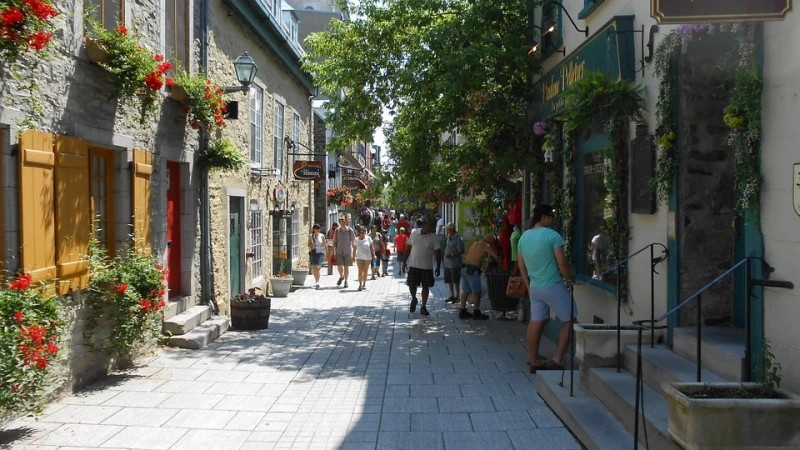
Pros:
- Cost of living (versus the national average): +2%
- Unemployment rate: 5.6%
- Residents reporting high life satisfaction: 62.3%
- Rush hour congestion: 111 hours
- 2023 Crime Severity Index (compared to a base of 100 in 2006): 45.73
Cons:
- Median after-tax income per household (2021): $65,500
Not only does Québec, QC, offer a scenic trip back in time, but also a safe, affordable, walkable place to live. Canada’s oldest fortified city is replete with festivals and cultural events, but newcomers to Canada had better start practicing their French – 78.1% of the population speak French as their primary language.
| City profile | |
|---|---|
| Metro area population (2024) | 858,000 |
| Average house price (2024) | $436,365 |
| Average monthly cost to own (2023) | $1,300 |
| Average monthly cost to rent (2023) | $1,355 |
| Minimum wage (2025) | $15.75 per hour |
| Residents with a regular healthcare provider (2021) | 78.4% |
| Average cost of car insurance (2024) | $1,112 per year |
| Average length of commute (2024) | 23.2 minutes |
| Average annual snowfall | 303.4 cm |
2. The Blueberries: Saguenay
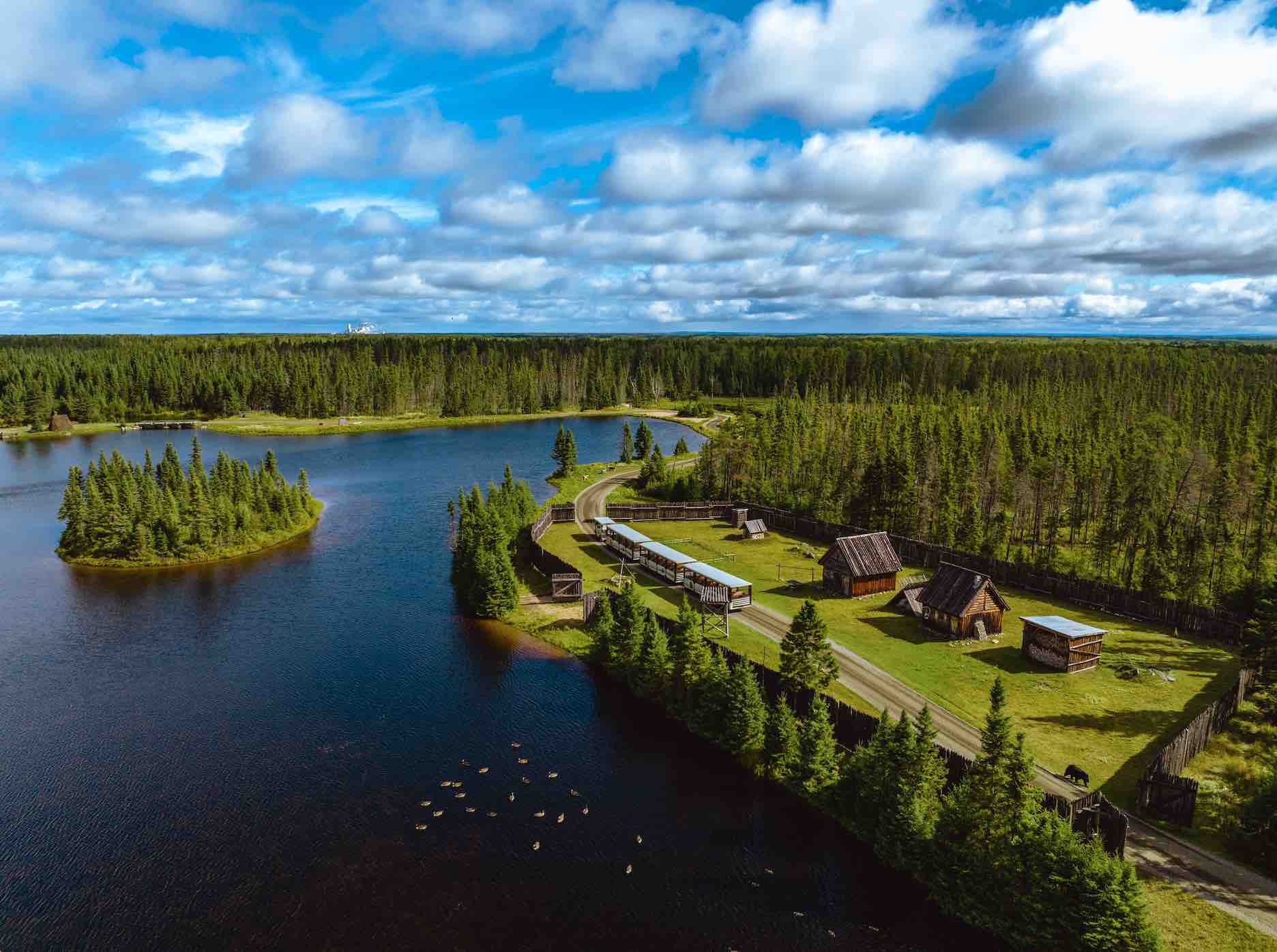 Image source: Tourisme Saguenay-Lac-Saint-Jean
Image source: Tourisme Saguenay-Lac-Saint-Jean
Pros:
- Cost of living (versus the national average): -9%
- Unemployment rate: 4.1%
- Residents reporting high life satisfaction: 61.72%
- 2023 Crime Severity Index (compared to a base of 100 in 2006): 51
Cons:
- Median after-tax income per household (2021): $61,200
- Walking score: 25/100
Be prepared to drive if you want to live in Saguenay, QC – its census area covers some 3,000 km of pristine, unspoiled wilderness in Northern Québec. The Francophone town is reportedly taking steps to add jobs in sales, business, and administration, which could boost its ranking on future versions of this list.
| City profile | |
|---|---|
| Metro area population (2021) | 161,567 |
| Average house price (2024) | $318,662 |
| Average monthly cost to own (2021) | $1,043 |
| Average monthly cost to rent (2021) | $684 |
| Minimum wage (2025) | $15.75 per hour |
| Residents with a regular healthcare provider (2021) | 74.8% |
| Average cost of car insurance (2024) | $1,112 per year |
| Average length of commute (2024) | 17.6 minutes |
| Average annual snowfall | 232 cm |
3. Bytown and Little Chicago: Ottawa–Gatineau
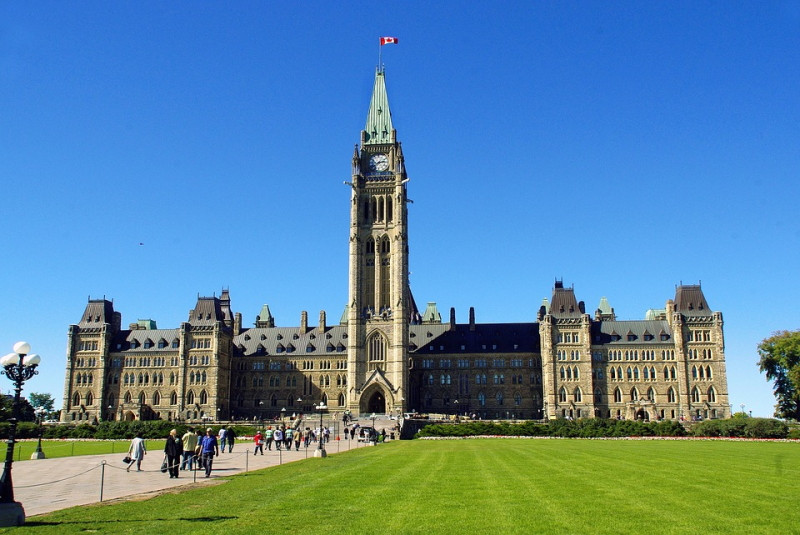
Pros:
- Median after-tax income per household (2020): $84,000
- Residents reporting high life satisfaction: 54.4%
- Rush hour congestion: 123 hours
- 2023 Crime Severity Index (compared to a base of 100 in 2006): 54.1- 61.7
Cons:
- Cost of living (versus the national average): +22%
- Unemployment rate: 6.2%
The nation’s capital metropolitan area leads the way regarding the arts, festivals, museums, and employment, with an average annual salary of $70,151 and hourly pay of $35.98. You won’t need much French to get by (at least on one side of the river), but you should buy a thick parka – the Ottawa–Gatineau region is the seventh-coldest capital in the world.
| City profile | |
|---|---|
| Metro area population (2021) | 1,488,307 |
| Average house price (2024) | $645,800 |
| Average monthly cost to own (2024) | $1,942 |
| Average monthly cost to rent (2024) | $2,165 |
| Minimum wage (2025) | $17.20 per hour ($15.75 in Québec) |
| Residents with a regular healthcare provider (2021) | 89.7% |
| Average cost of car insurance (2024) | $2,025 per year |
| Average length of commute (2024) | 26.1 minutes |
| Average annual snowfall | 177 cm |
4. The Royal City: Guelph
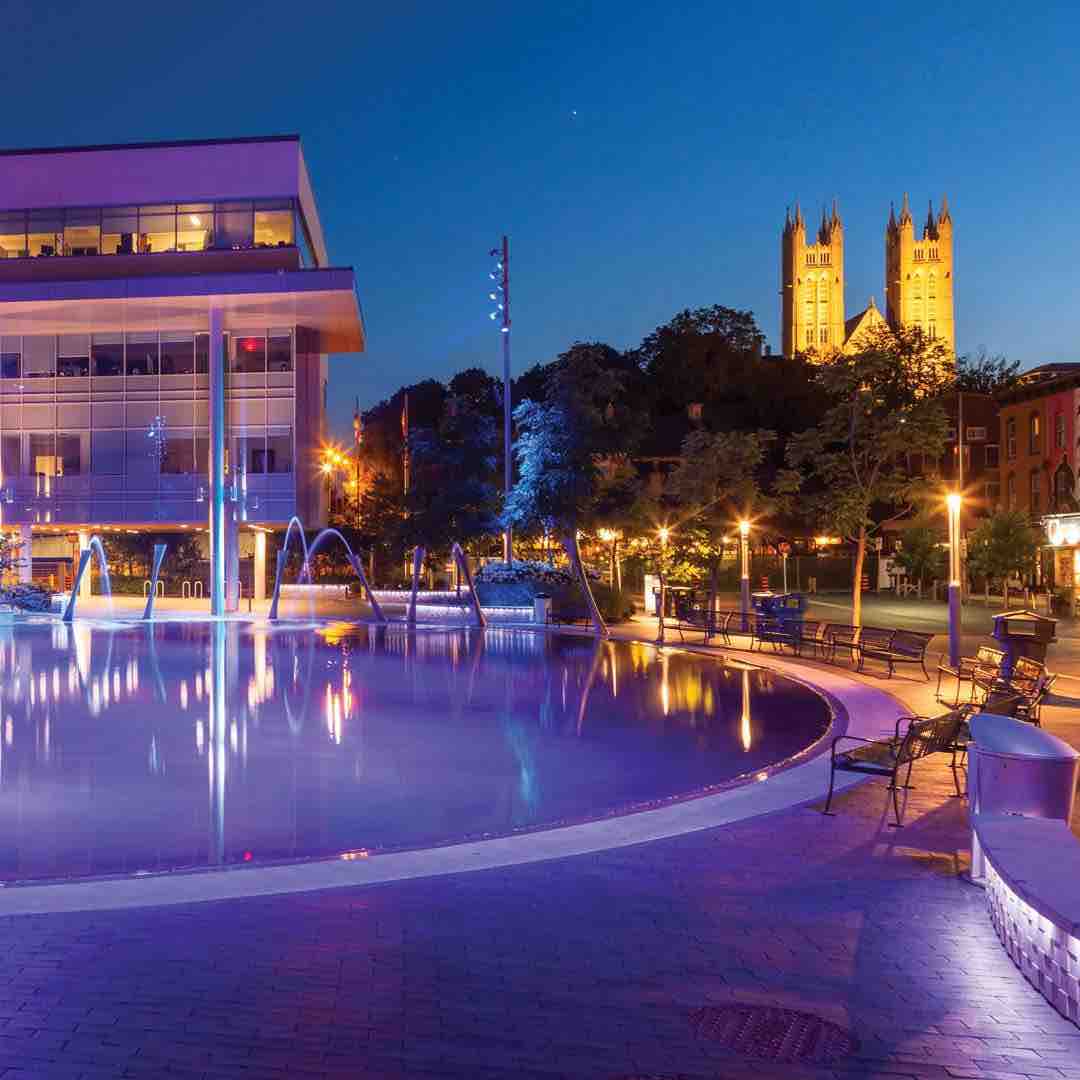 Image source: Gather in Guelph
Image source: Gather in Guelph
Pros:
- Median after-tax income per household (2020): $84,000
- Residents reporting high life satisfaction: 54.2%
- 2023 Crime Severity Index (compared to a base of 100 in 2006): 55.52
Cons:
- Cost of living (versus the national average): +9%
- Unemployment rate: 6.9%
The town of Guelph, ON is the safest city on this list. While the number of people calling the police has increased in recent years, so has the funding for victim support and mobile crisis response services. Young families looking to settle down will also find an ample selection of English, French, public, private, and religious schools available, including the top-ranking University of Guelph.
| City profile | |
|---|---|
| Metro area population (2022) | 149,942 |
| Average house price (2024) | $792,100 |
| Average monthly cost to own (2021) | $1,718 |
| Average monthly cost to rent (2021) | $1,382 |
| Minimum wage (2025) | $17.20 per hour |
| Residents with a regular healthcare provider (2021) | 89.7% |
| Average cost of car insurance (2024) | $1,927 per year |
| Average length of commute (2021) | 22.3 minutes |
| Average annual snowfall | 155.1 cm |
5. The Blue Sky City: Calgary
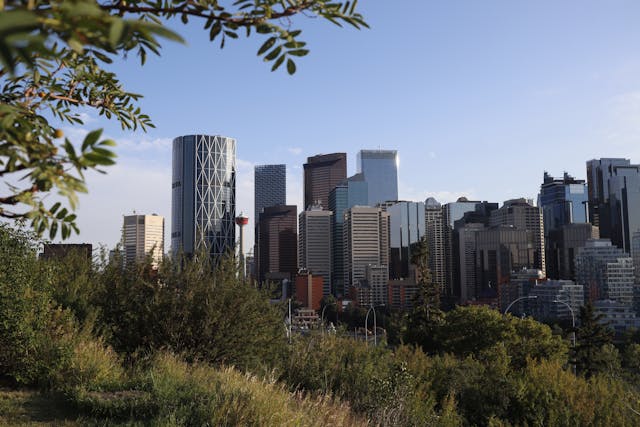
Pros:
- Median after-tax income per household (2020): $87,000
- Residents reporting high life satisfaction: 46.6%
- Rush hour congestion: 110 hours
- 2023 Crime Severity Index (compared to a base of 100 in 2006): 71
- Rate of impaired driving violations per 100,000 residents: 10.27
Cons:
- Cost of living (versus the national average): +16%
- Unemployment rate: 7.8%
The Blue Sky City is the jewel of the prairie provinces.
Based on its stability and high quality of health, culture, education, and infrastructure, the Economist named Calgary, AB the 7th Most Livable City in the World in 2023. While the oil and gas industry led the city’s economic success in the early 2000s, many other successful businesses have since grown in its wake, including opportunities in trade, science, health, and construction.
| City profile | |
|---|---|
| Metro area population (2023) | 1,682,509 |
| Average house price (2023) | $662,250 |
| Average monthly cost to own (2021) | $1,802 |
| Average monthly cost to rent (2021) | $1,416 |
| Minimum wage (2025) | $15.00 per hour |
| Residents with a regular healthcare provider (2021) | 87.3% |
| Average cost of car insurance (2024) | $2,675 per year |
| Average length of commute (2024) | 25.3 minutes |
| Average annual snowfall | 144 cm |
6. Queen of the Eastern Townships: Sherbrooke
 Image source: Ville de Sherbrooke
Image source: Ville de Sherbrooke
Pros:
- Cost of living (versus the national average): -11%
- Unemployment rate: 5.3%
- Residents reporting high life satisfaction: 60.4%
- 2023 Crime Severity Index (compared to a base of 100 in 2006): 52.18
Cons:
- Median after-tax income per household (2020): $56,800
- Walk score: 39/100
Named one of Maclean’s Best Affordable Places to Live in 2024, picturesque Sherbrooke, QC is just waiting for an economic boom to take it to the top. In 2021, 81% of residents reported participating in outdoor activities close to home, reflecting the region’s incredible wealth of parks, lakes, rivers, and mountain and cycling trails.
| City profile | |
|---|---|
| Metro area population (2023) | 176,684 |
| Average house price (2023) | $515,155 |
| Average monthly cost to own (2021) | $1,090 |
| Average monthly cost to rent (2023) | $1,332 |
| Minimum wage (2025) | $15.75 per hour |
| Residents with a regular healthcare provider (2021) | 78.4% |
| Average cost of car insurance (2024) | $1,112 per year |
| Average length of commute (2021) | 18.8 minutes |
| Average annual snowfall | 286.5 cm |
7. The City of Saints: Montreal

Pros:
- Walk score: 85/100
- Transit score: 64/100
- Bike score: 64/100
- Residents living within 500 m of a public transit stop: 87.5%
- 2023 Crime Severity Index (compared to a base of 100 in 2006): 63.2
Cons:
- Cost of living (versus the national average): +15%
- Median after-tax income per household (2020): $65,500
- Unemployment rate: 8.7%
- Poverty rate: 11.7%
- Rush hour congestion: 180 hours
If you can’t live without the culture and vibrancy of a mega-metropolis, Montréal is your best choice. It’s more affordable than Ottawa, Toronto, or Vancouver, and the city’s excellent biking and public transportation infrastructure means you don’t have to pay for a car.
Depending on your job, you might not need to speak French, either; more than 50% of the population is fluent in English.
| City profile | |
|---|---|
| Metro area population (2021) | 4,290,000 |
| Average house price (2024) | $620,644 |
| Average monthly cost to own (2021) | $1,420 |
| Average monthly cost to rent (2024) | $1,735 |
| Minimum wage (2025) | $15.75 per hour |
| Residents with a regular healthcare provider (2021) | 78.4% |
| Average cost of car insurance (2024) | $1,112 per year |
| Average length of commute (2024) | 29 minutes |
| Average annual snowfall | 211 cm |
8. Three Rivers: Trois-Rivieres
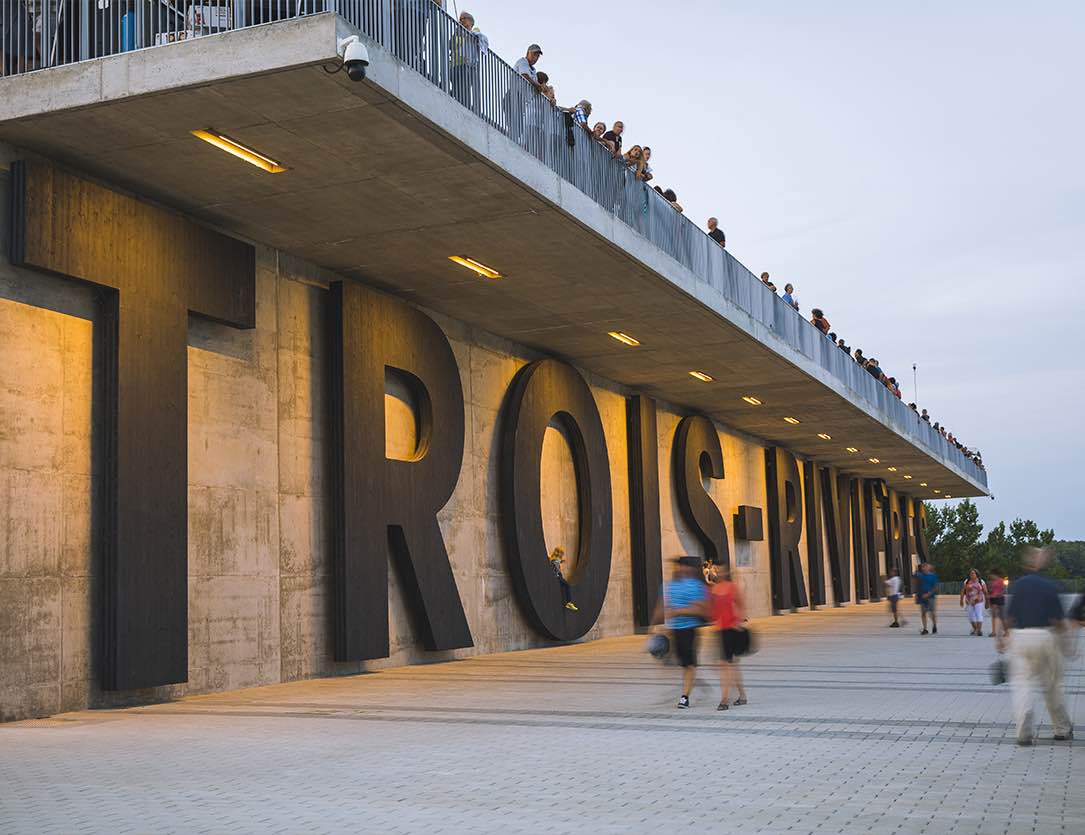 Image source: Tourisme Trois-Rivieres
Image source: Tourisme Trois-Rivieres
Pros:
- Cost of living (versus the national average): -5%
- Unemployment rate: 5.6%
- Residents reporting a high degree of perceived stress: 18.7%
- Residents reporting very good to excellent mental health: 73.3%
- 2023 Crime Severity Index (compared to a base of 100 in 2006): 60.29
Cons:
- Median after-tax income per household (2020): $55,200
- Walk score: 32/100
The area of Trois-Rivières, QC encompasses 6 towns on the banks of the St. Lawrence River between Montréal and Québec. While staid, its population and language are slowly diversifying as young people flock to its growing cultural scene, technology parks, and schools, including the summertime Cirque du Soleil camp.
| City profile | |
|---|---|
| Metro area population (2021) | 143,195 |
| Average house price (2024) | $484,557 |
| Average monthly cost to own (2021) | $951 |
| Average monthly cost to rent (2024) | $1,048 |
| Minimum wage (2025) | $15.75 per hour |
| Residents with a regular healthcare provider (2021) | 78.4% |
| Average cost of car insurance (2024) | $1,112 per year |
| Average length of commute (2021) | 18.2 minutes |
| Average annual snowfall | 259 cm |
9. The Ambitious City: Hamilton
 Image source: Tourism Hamilton
Image source: Tourism Hamilton
Pros:
- Median after-tax income per household (2020): $80,000
- Rush hour congestion: 114 hours
- 2023 Crime Severity Index (compared to a base of 100 in 2006): 59.48
Cons:
- Cost of living (versus the national average): +13%
- Unemployment rate: 7.1%
As the busiest port of the Canadian Great Lakes, Hamilton has seen many people come and go – but more are staying to take advantage of its growing arts, sports, and technology industries. The city’s 2021–2025 Economic Development Action Plan identifies 13 ambitious goals, including a 25% increase in immigration and generating $2.5 billion worth of industrial/commercial construction.
| City profile | |
|---|---|
| Metro area population (2021) | 597,010 |
| Average house price (2024) | $772,705 |
| Average monthly cost to own (2021) | $1,690 |
| Average monthly cost to rent (2021) | $1,328 |
| Minimum wage (2025) | $17.20 per hour |
| Residents with a regular healthcare provider (2021) | 89.7% |
| Average cost of car insurance (2024) | $1,927 per year |
| Average length of commute (2024) | 30.6 minutes |
| Average annual snowfall | 100 cm |
10. The 6ix: Toronto
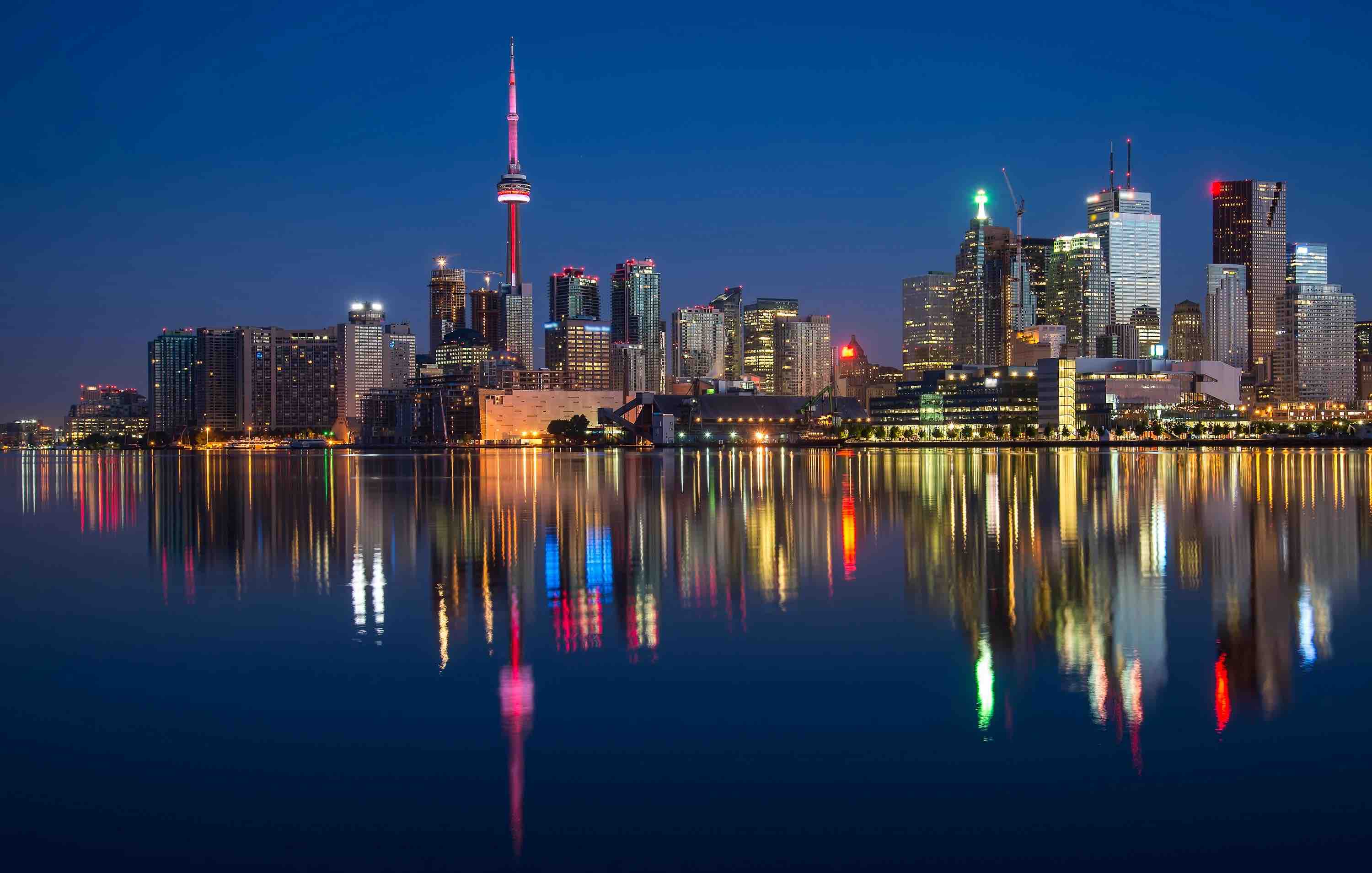
Pros:
- Median after-tax income per household (2020): $85,000
- Transit score: 78/100
- Residents living within 500 m of a public transit stop: 85.3%
- 2023 Crime Severity Index (compared to a base of 100 in 2006): 58.54
Cons:
- Cost of living (versus the national average): +30%
- Unemployment rate: 8.5%
- Poverty rate: 13.2%
- Rush hour congestion: 199 hours
Yes, it’s expensive, yes, it’s noisy, and yes, it’s the most congested city in North America, but there’s a reason Toronto, ON continues to attract new residents in droves. The quality of its economy, public transit, and healthcare system (not to mention its dominance in the financial and creative fields) are more than enough to make up for its lack of affordability – and you asked for the best, remember?
| City profile | |
|---|---|
| Metro area population (2021) | 6,202,225 |
| Average house price (2024) | $1,525,00 |
| Average monthly cost to own (2021) | $2,108 |
| Average monthly cost to rent (2021) | $2,149 |
| Minimum wage (2025) | $17.20 per hour |
| Residents with a regular healthcare provider (2021) | 89.7% |
| Average cost of car insurance (2024) | $1,896 per year |
| Average length of commute (2024) | 33.3 minutes |
| Average annual snowfall | 100 cm |
How we get our rankings
We created our list from the top 39 most-populated Census Metropolitan and Census Agglomeration Areas (CA and CMA) in Canada – plus the most-populated town or city in each province or territory – for a total of 52 places to live.
Next, we chose to measure 5 categories (affordability, employment, health and happiness, transportation, and safety) and selected 5–10 key indicators to compare in each.
From most to least used, our key indicator data sources were:
- The 2021 Census of Population by Statistics Canada
- The Canadian Real Estate Association and WOWA.ca
- The Economic Research Institute
- The 2023 Traffic Index by TomTom
- WalkScore.com
- The 2022 Canadian Private Passenger Vehicle Insurance Rate Comparisons report completed by Ernst & Young, Arc Insurance, the Financial Services Regulatory Authority of Ontario, and the ThinkInsure website
We awarded points based on how high a place ranked, not its quality. For example, if a candidate scored 4 out of a possible 5, it indicated that it ranked higher than 80% of the competition, not that it fell 20% short of perfection. Every category is weighted equally.
Regrettably, we couldn’t find enough data to form a reliable, standardized basis of comparison for culture or education.
Bonus: The best 5 in 5 categories
We tried to substitute missing information with reliable sources, but the rankings of certain towns and cities inevitably suffered due to a lack of data. If your hometown didn’t make the list, don’t blame us – blame the lack of statistics!
In this section, we give some overlooked entrants their due by examining the top 5 places to live in all 5 categories.
1. Most affordable: Sault Ste. Marie
The Soo is one of the cheapest places to live in Ontario. Nearly 70% of residents own their own home, it costs about $1,230 per month to rent, and the average daily commute lasts just 14 minutes. Just don’t ask us about the state of its healthcare or police department.
The 5 most affordable places to live in Canada:
| Affordability rank | City | Cost of living (versus national average; 2024) | Average monthly housing cost (2025) | Average house price (2024) |
|---|---|---|---|---|
| 1 | Sault Ste. Marie, ON | +2% | $1,230 | $312,000 |
| 2 | Saint John, NB | -3% | $1,016 | $388,000 |
| 3 | Fredericton, NB | +2% | $1,428 | $340,320 |
| 4 | Saguenay | -9% | $1,688 | $319,891 |
| 5 | Trois-Rivières | -5% | $1,082 | $371,000 |
2. Best working opportunities: Whitehorse, YK
Employers may pay top dollar for working in a remote location but the 4 highest-earning places to live rank at the bottom in nearly every other category. Whitehorse’s lack of health data and astonishing rate of 1,567 traffic violations per 100,000 residents sunk its chances of ever making the top 10.
The 5 most lucrative places to work in Canada:
| Employment rank | City | Median after-tax income per household (2021) | Unemployment rate (2024) | Poverty rate (2023) |
|---|---|---|---|---|
| 1 | Whitehorse, YT | $95,000 | 4.8% | 12.9% |
| 2 | Yellowknife, NT | $124,000 | 4.7% | 24.2% |
| 3 | Grande Prairie, AB | $88,000 | 3.7% | 9.7% |
| 4 | Iqaluit, NU | $104,300 | 4.8% | 24.2% |
| 5 | Calgary, AB | $116,000 | 7.9% | 10% |
3. Healthiest and happiest: Halifax, NS
The healthiest and happiest places to live in Canada are middling performers in most other categories, but it’s a trade-off the residents seem willing to make. Haligonians enjoy good air quality, low infant mortality rates, and a high rate of participation in outdoor activities close to home.
The 5 healthiest and happiest places to live in Canada:
| Health and happiness rank | City | Residents reporting "very good" to “excellent” perceived health (2021) | Residents reporting "very good" to “excellent” perceived mental health (2021) | Residents perceiving "most days" as stressful (2021) |
|---|---|---|---|---|
| 1 | Halifax, NS | 64.1% | 64.4% | 19.8% |
| 2 | Saguenay, QC | 62.8% | 78.8% | 20.8% |
| 3 | St. John’s, NL | 68.9% | 71.3% | 12.5% |
| 4 | Québec, QC | 69.4% | 76.8% | 22.3% |
| 5 | Guelph, ON | 64.4% | 63.9% | 21.5% |
4. Best transportation: Montréal
The Transportation category favours large cities with plenty of amenities and a robust public transportation network. Montréal is a standout for providing dedicated bike lanes and the BIXI rental system. Biking to the park under dappled shade on a warm summer’s day is something every Canadian should experience.
The 5 best places to live without a car in Canada:
| Transportation rank | City | Walk score (out of 100) | Transit score (out of 100) | Bike score (out of 100) | Percentage of residents living within 500m of a public transit stop (2021) |
|---|---|---|---|---|---|
| 1 | Montréal, QC | 65 | 67 | 73 | 87.5% |
| 2 | Victoria, BC | 76 | 62 | 80 | 84.6% |
| 3 | Winnipeg, MB | 48 | 51 | 61 | 84.8% |
| 4 | Vancouver, BC | 80 | 74 | 79 | 84.4% |
| 5 | Regina, SK | 44 | 41 | 56 | 84.2% |
5. Safest: Guelph, ON
While moderately sized communities dominate the Safety rankings, we need to give the Guelph Social and Police Services their due. Collectively, Wellington County operates housing, emergency shelter, and newcomer settlement programs, as well as 529 Garage, Coffee With A Cop, and Project LifeSaver, among others.
The 5 safest places to live in Canada:
| Safety rank | City | Traffic violations per 100,000 people (2023) | Impaired driving violations per 100,000 people (2023) | 2023 Crime Severity Index (compared to a base of 100 in 2006) |
|---|---|---|---|---|
| 1 | Guelph, ON | 149.3 | 90.1 | 55.5 |
| 2 | St. Catharines–Niagara, ON | 161.6 | 103.9 | 54.5 |
| 3 | Barrie, ON | 198.2 | 132.7 | 48.1 |
| 4 | Ottawa–Gatineau, ON | 196.5 | 84.0 | 54.1- 61.7 |
| 5 | Hamilton, ON | 136.6 | 82.5 | 59.5 |
Did You Know? The place with the shortest average commute is Iqaluit (8.7 minutes), the cheapest place to rent is Trois-Rivières ($1,048 per month), and the place with the highest percentage of residents with a post-secondary degree is Québec.
FAQ
Where is the best place to live in Canada?
The best place to live in Canada is Québec, QC, considering its high degree of affordability, health care, safety, and access to transportation.
Which Canadian city has the best quality of life?
Halifax, NS has an extremely low infant mortality rate, a high self-reported degree of life satisfaction, and a high percentage of residents with a regular healthcare provider.
Where is the most affordable place to live in Canada?
Sault Ste. Marie, ON is highly affordable thanks to its low cost of living and housing prices.
Where is the most unaffordable place to live in Canada?
With an average home price in excess of $1.2 million, an average monthly rent of $1,600+, and a cost of living 42% higher than the national average, Vancouver, BC is the most unaffordable city in Canada.
Is it cheaper to live in Ontario or Alberta?
According to the Economic Research Institute, it’s an average of 1% cheaper (compared to the national average) to live in Alberta than in Ontario.
creditcardGenius is the only tool that compares 126+ features of 228 Canadian credit cards using math-based ratings and rankings that respond to your needs, instantly. Take our quiz and see which of Canada's 228 cards is for you.



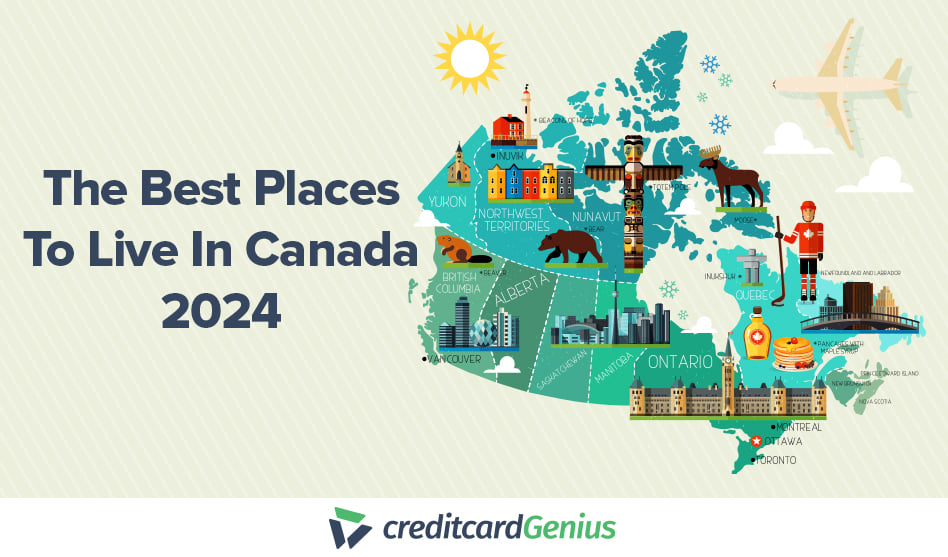





 GC:
GC: 



































 $100 GeniusCash + Earn up to 15,000 Welcome Bonus Membership Rewards® Points.*
$100 GeniusCash + Earn up to 15,000 Welcome Bonus Membership Rewards® Points.*
Comments
Leave a comment
Required fields are marked with *. Your email address will not be published.
Showing 29 comments